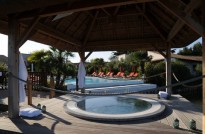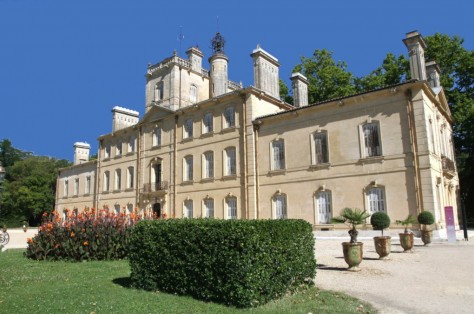
The estate of the Chateau d'Avignon is located in the heart of the Camargue, by the banks of the Petit Rhône, between Saintes Maries de la Mer and Arles, in very original natural surroundings. Today it spreads out over a little more than 21 hectares. The Chateau d'Avignon is the property of the General Council of the Bouches-du Rhône.
The building up of the estate was the work of Jean-François d'AVIGNON, 1694-1770, a native of the Comtat Venaissin.His mother Jeanne d'ARLATAN, born to a rich Arles family, bought the Mas de SOMEYRE in 1720. Around 1739-1740, the existing house was changed, extended even, to become the château d'Avignon, as confirmed by a sketch from 1771. After his death, having had no children, the chateau passed successively through several hands before being purchased in 1811 with its 5500 hectares by the general de MIOLLIS, count of the Empire. In 1813 its total area reached 19,224 hectares.
Louis NOILLY-PRAT (1845-1932), a famous wine merchant, bought the estate in 1893. This entrepreneur was the oldest son of Claudius PRAT, a Marseille trader and Anne-Rosine NOILLY, originating from the high bourgeoisie of Lyon. A man of industry and trade, he founded in 1870 the firm NOILLY-PRAT producing and exporting vermouth and absinthe. He completely changed his residence, giving it the most modern of comforts and the latest of technical progress. He surrounded himself with competent personalities such as Auguste VERAN, an architect of historic monuments from Arles, Louis PEYRON, architect from Marseille, and Auguste BLANQUI, master cabinetmaker from Marseille, very well-known at the time.
This latter made all the interior fittings, all of the woodwork, the door and window frames and all the furniture in the chateau d'Avignon. The architecural plans showing the state of the château, drawn up by Auguste VERAN in July 1893, attest to some changes, notably the addition of an extra bay at the end of the east wing and the moving of the monumental stairway. On the other hand, the other constructions that make up the outbuildings were built on the order of Louis NOILLY-PRAT, set away from château, between 1893 and 1900. This group of very homogenous buildings go together with the mansion and testify to the research in modernity carried out at the end of the 19th century in a region where water is omnipresent. Together, they illustrate in an exceptional manner the themes of hygiene, comfort and the domestic organization of the bourgeois businessman in the provinces at the end of the century.







